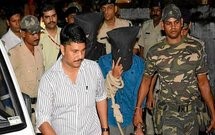 When Yasin Bhatkal, cofounder of Indian Mujahideen (IM) was arrested on 29 August 2013 at India-Nepal border, there was more of disbelief than relief.
When Yasin Bhatkal, cofounder of Indian Mujahideen (IM) was arrested on 29 August 2013 at India-Nepal border, there was more of disbelief than relief.
The incredulity was because he operated with different aliases – Ahmed Siddibappa, Imran, Asif, and Shahrukh – at different places across India. He was also careful not to overly use mobile phones or emails for communication; did not stay in a particular place in India for more than a couple of weeks; even so, he preferred outskirts of towns or rural areas that are Muslim-dominated. Though wanted by counter-terrorism units of 12 states of India — Uttar Pradesh, Bihar, Delhi, Maharashtra, Rajasthan, Gujarat, Madhya Pradesh, Andhra Pradesh, Karnataka, Kerala, Tamil Nadu and West Bengal — Yasin Bhatkal evaded them for several years.
In fact, he was lucky at least three times from being nearly caught by the police. Surprisingly, he was once arrested in Kolkatta, but was given bail because the West Bengal police did not realise that he was indeed the IM kingpin Yasin Bhatkal. Yet, Yasin has managed to successfully plant bombs in Delhi, Pune, Bangalore, Mumbai, Ahmedabad, Surat, Jaipur, Hyderabad and Varanasi.
No wonder, he has been dubbed as “the ghost who bombs”. He is so hardened that his remark on bomb blasts was without any remorse: "these things (bomb blasts) happen; there is nothing new about them." The present arrest was possible only after a solid and continuous trail for over six months.
Now, the crucial question is: what is the significance of Yasin’s arrest from India’s counter-terrorism point of view? The importance of the arrest should be seen from the role and importance of Yasin to the Indian Mujahideen’s objectives and functions. He has been the terror group’s chief recruiter and bomb-maker for quite some time.
He personally built a network of sleeper cells and modules in places like Aurangabad, Jalna, Beed, Nagpur, Pune, Hyderabad and later at Darbhanga in Bihar. These places were preferred for indoctrinating Muslim youth due to the high density of Muslim population; and, in the case of Darbhanga, its proximity to the porous Indo-Nepal border. Minus Yasin, sustenance of present modules is in big question; also new ones are bound to suffer.
Having liaised with actors based in Pakistan, Yasin should be in a position to explain in detail the extent of Pakistan’s involvement in terror attacks in India, especially the role of Pakistan’s intelligence agency, ISI. He could help find answers to the many unanswered questions. Are the Pakistani claims that it really is not in a position to control anti-Indian militant groups based in its soil, valid? Or, is Pakistan controlling all activities, from planning to execution of terror attacks against India? Are other IM leaders – Iqbal and Riaz Bhatkal – hiding in Pakistan? If so, where are they? Who have been helping them? What are their plans for the future?
Also Yasin may have information about the various Pakistan-based militant groups that are linked to IM: their leadership, motivations, funding, recruitment, training, bases (both political and military), logistical support, their linkages with state and non-state actors in Pakistan, other internal and external networks, their modules and ‘sleeper cells’ in India, process of selection of targets, plans for future attacks, and extent of their connections with Indian terror groups such as SIMI and IM. Not to mention, the IM leader’s interrogation would throw a deep insight into the working of the IM: its leadership, organisational structure, recruitment pattern, funding sources and network, existing modules and sleeper cells, their future targets, local and external accomplices and so on.
Most importantly, Yasin Bhatkal’s case would help the Indian authorities to understand the various causes for radicalisation of Indian Muslim youth, those groups involved in radicalizing them, on how the youth graduate to indulge in terror attacks against their own people, and, in the process, how they get their lives and ambitions trapped and finally destroyed.
From the prosecution point of view, Yasin Bhatkal could clear air in few cases like the Mumbai train blasts case of 2007 and the German Bakery blast case of 2010 where there is some confusion as to the real perpetrators. From law enforcement point of view, information from the IM leader would help the internal security mechanism to review the present counter-terrorism strategy and plug loopholes.
Two lessons come out clearly in Yasin Bhatkal’s case. One is the absence of a national database on criminals or terror suspects and network of all police stations. Such a database would have nailed Yasin long back. The second lesson is lack of coordination between central and state agencies and among various state police forces. Such deficiencies helped Yasin to stay free for long.
Courtesy : Institute of Peace and Conflict Studies (http://www.ipcs.org)